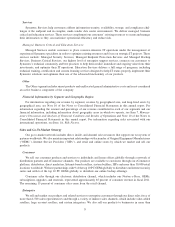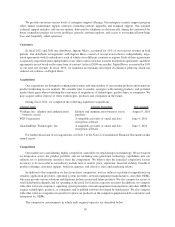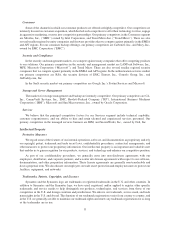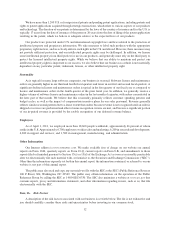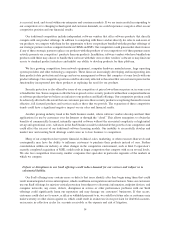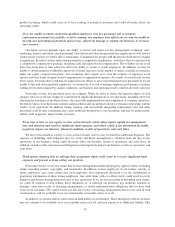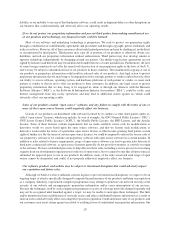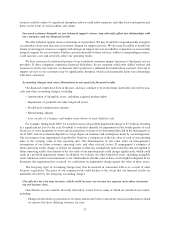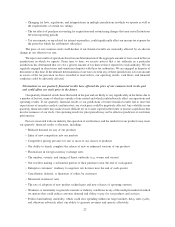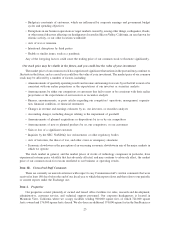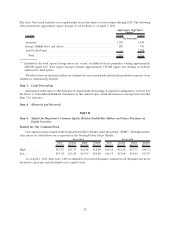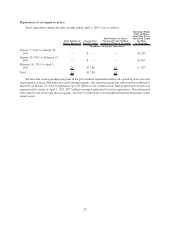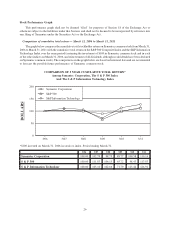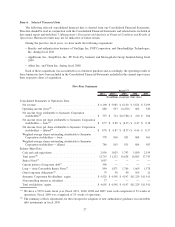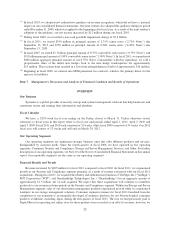Symantec 2011 Annual Report Download - page 88
Download and view the complete annual report
Please find page 88 of the 2011 Symantec annual report below. You can navigate through the pages in the report by either clicking on the pages listed below, or by using the keyword search tool below to find specific information within the annual report.• Central bank and other restrictions on our ability to repatriate cash from our international subsidiaries or to
exchange cash in international subsidiaries into cash available for use in the U.S.
• Fluctuations in currency exchange rates and economic instability such as higher interest rates in the U.S. and
inflationary conditions that could reduce our customers’ ability to obtain financing for software products or
that could make our products more expensive or could increase our costs of doing business in certain
countries
• Limitations on future growth or inability to maintain current levels of revenues from international sales if we
do not invest sufficiently in our international operations
• Longer payment cycles for sales in foreign countries and difficulties in collecting accounts receivable
• Difficulties in staffing, managing, and operating our international operations, including difficulties related to
administering our stock plans in some foreign countries
• Difficulties in coordinating the activities of our geographically dispersed and culturally diverse operations
• Seasonal reductions in business activity in the summer months in Europe and in other periods in other
countries
• Costs and delays associated with developing software and providing support in multiple languages
• Political unrest, war, or terrorism, or regional natural disasters, particularly in areas in which we have
facilities
A significant portion of our transactions outside of the U.S. are denominated in foreign currencies. Accord-
ingly, our revenues and expenses will continue to be subject to fluctuations in foreign currency rates. We expect to
be affected by fluctuations in foreign currency rates in the future, especially if international sales continue to grow
as a percentage of our total sales or our operations outside the United States continue to increase.
The level of corporate tax from sales to our non-U.S. customers is generally less than the level of tax from sales
to our U.S. customers. This benefit is contingent upon existing tax regulations in the U.S. and in the countries in
which our international operations are located. Future changes in domestic or international tax regulations could
adversely affect our ability to continue to realize these tax benefits.
Our products are complex and operate in a wide variety of computer configurations, which could result
in errors or product failures.
Because we offer very complex products, undetected errors, failures, or bugs may occur, especially when
products are first introduced or when new versions are released. Our products are often installed and used in large-
scale computing environments with different operating systems, system management software, and equipment and
networking configurations, which may cause errors or failures in our products or may expose undetected errors,
failures, or bugs in our products. Our customers’ computing environments are often characterized by a wide variety
of standard and non-standard configurations that make pre-release testing for programming or compatibility errors
very difficult and time-consuming. In addition, despite testing by us and others, errors, failures, or bugs may not be
found in new products or releases until after commencement of commercial shipments. In the past, we have
discovered software errors, failures, and bugs in certain of our product offerings after their introduction and, in some
cases, have experienced delayed or lost revenues as a result of these errors.
Errors, failures, or bugs in products released by us could result in negative publicity, damage to our brand,
product returns, loss of or delay in market acceptance of our products, loss of competitive position, or claims by
customers or others. Many of our end-user customers use our products in applications that are critical to their
businesses and may have a greater sensitivity to defects in our products than to defects in other, less critical,
software products. In addition, if an actual or perceived breach of information integrity or availability occurs in one
of our end-user customer’s systems, regardless of whether the breach is attributable to our products, the market
perception of the effectiveness of our products could be harmed. Alleviating any of these problems could require
significant expenditures of our capital and other resources and could cause interruptions, delays, or cessation of our
18


